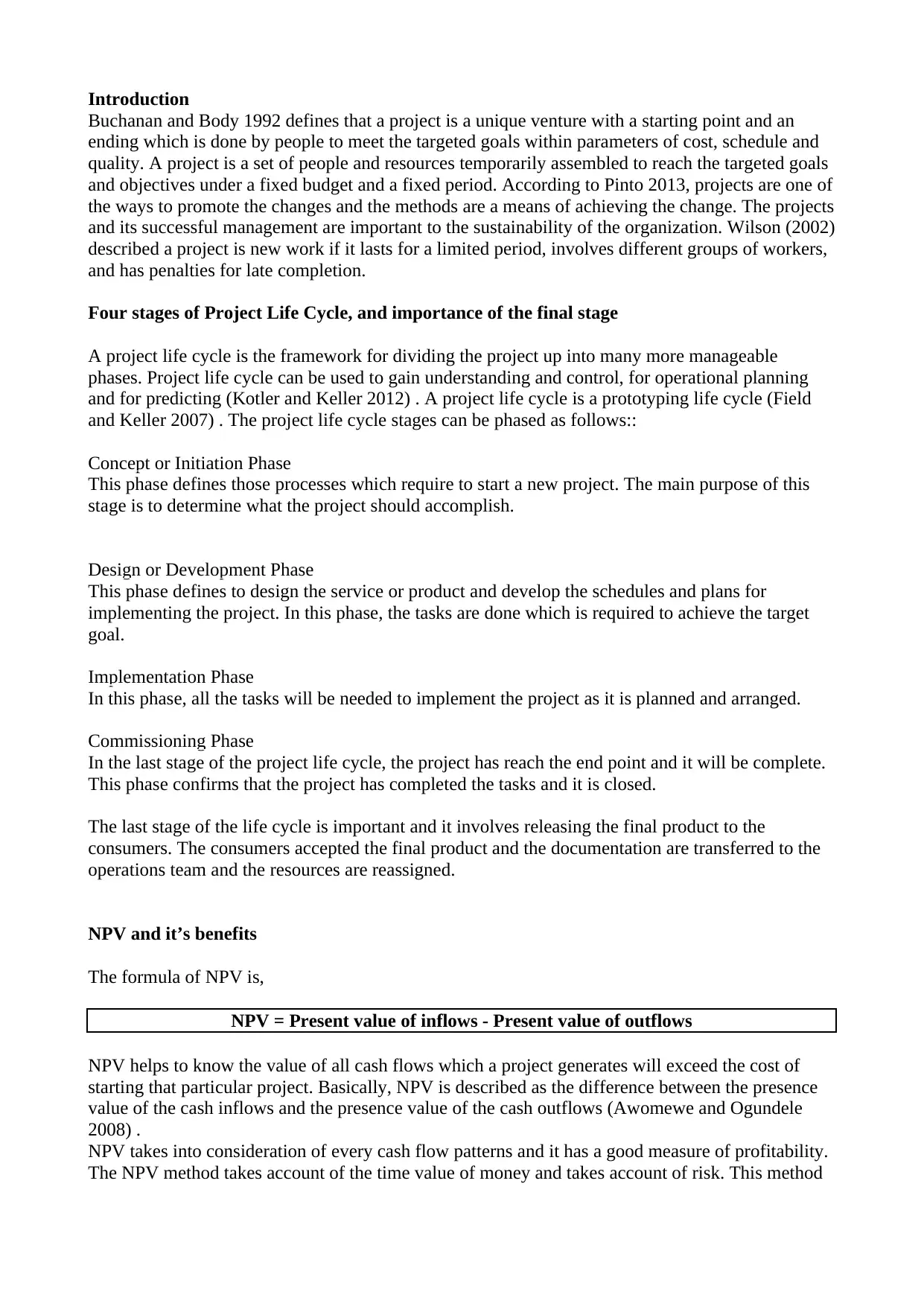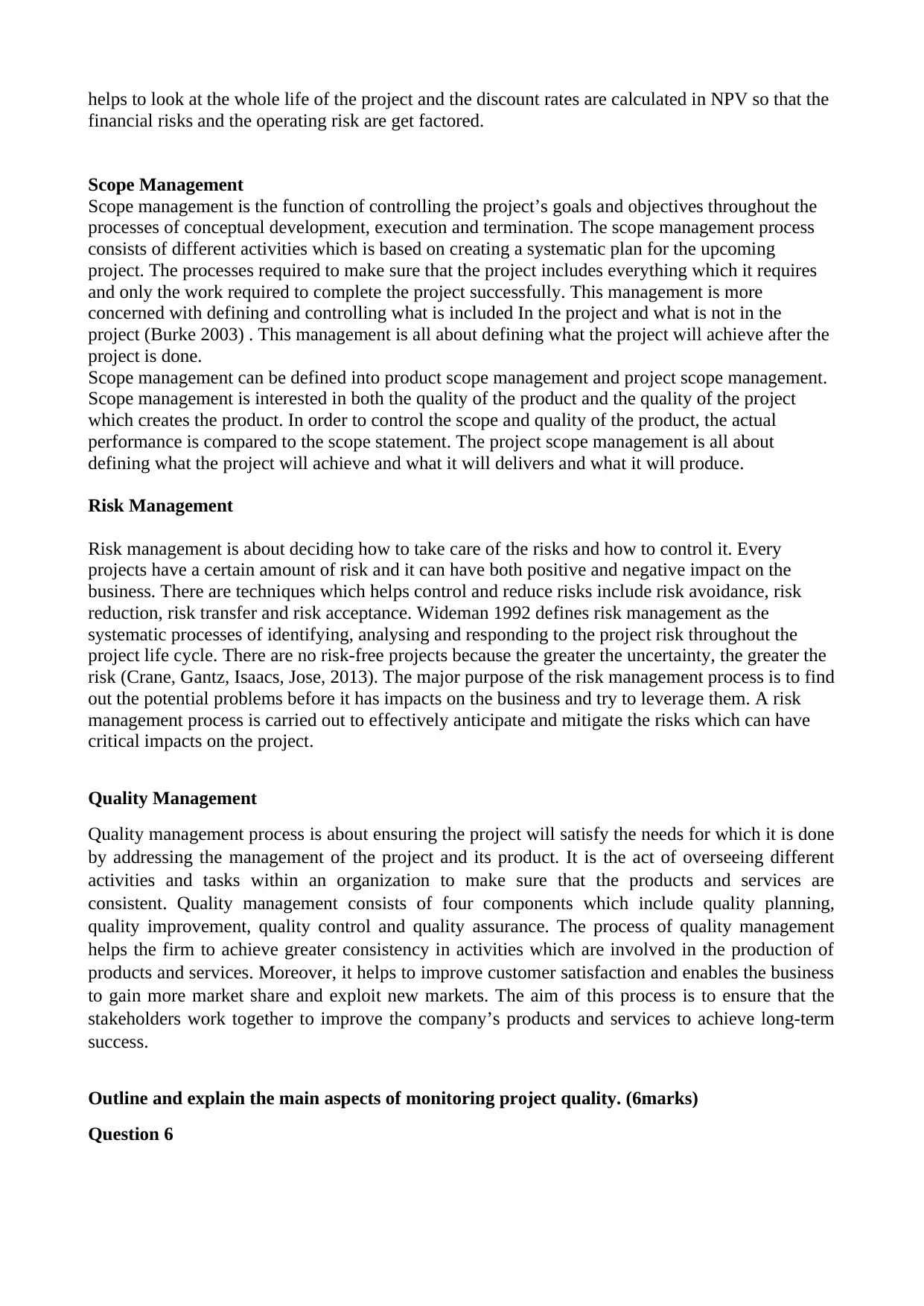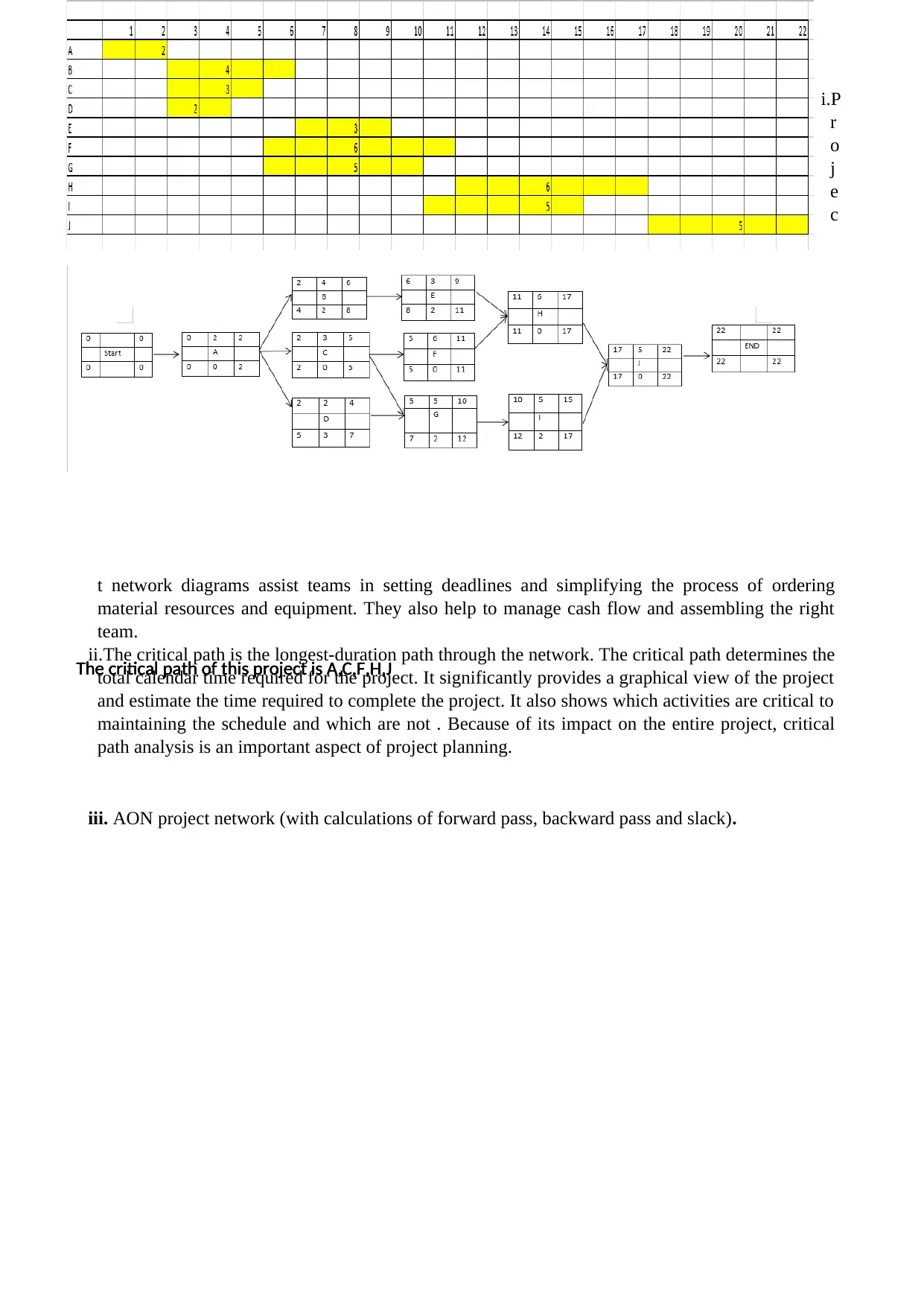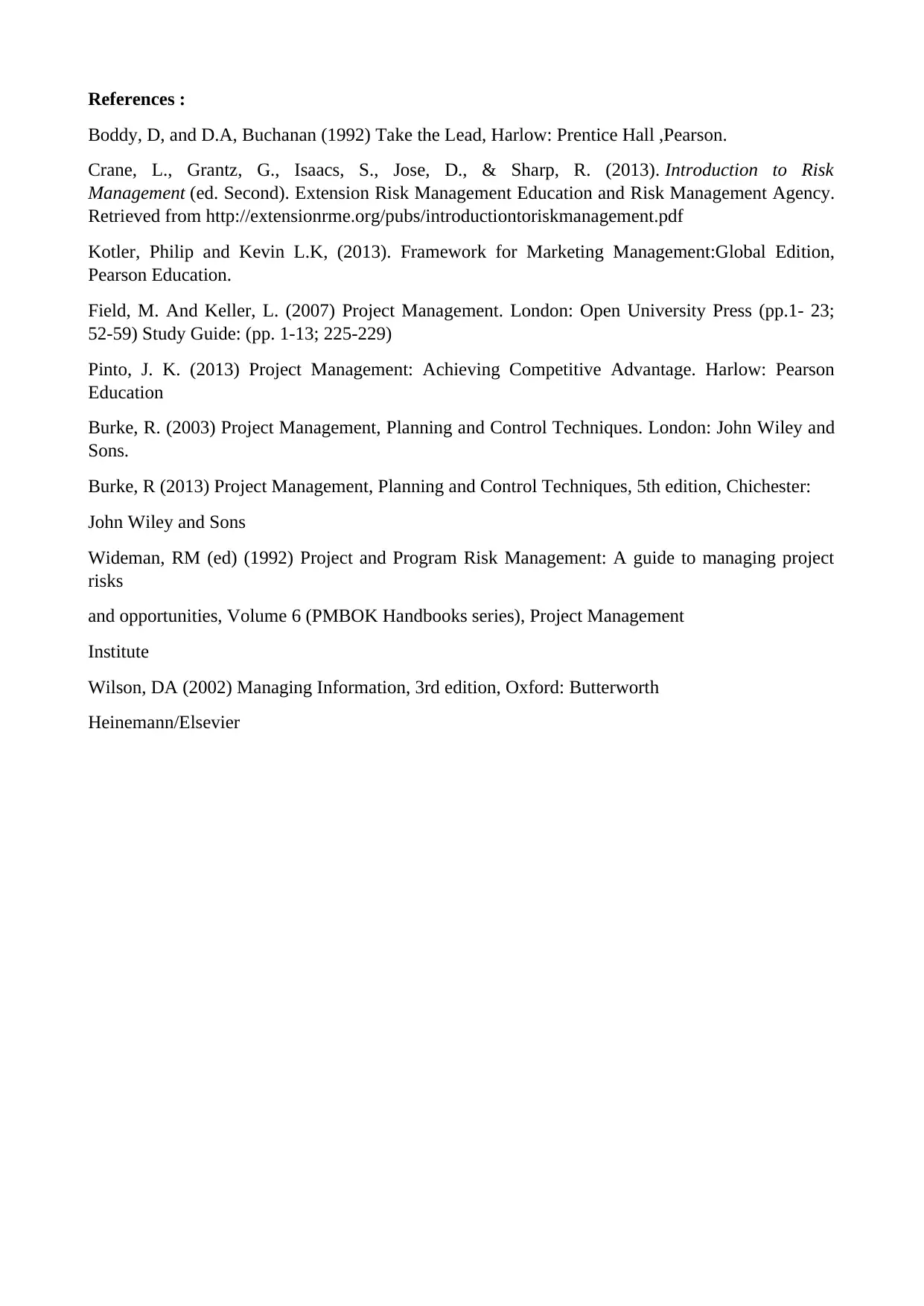Comprehensive Project Management Report: Analysis and Strategies
VerifiedAdded on 2020/09/21
|5
|1474
|105
Report
AI Summary
This report provides a comprehensive overview of project management principles and practices. It begins with a definition of a project and its life cycle, outlining the stages from initiation to commissioning. The report delves into key concepts such as Net Present Value (NPV) and its benefits in financial decision-making, emphasizing its role in evaluating project profitability. Scope management, risk management, and quality management are explored in detail, defining their processes and importance in controlling project goals, mitigating potential problems, and ensuring product and service consistency. The report also examines project network diagrams, critical path analysis, and their impact on setting deadlines, resource management, and overall project timeline determination. References from various authors are included to support the discussed concepts and methodologies.

Introduction
Buchanan and Body 1992 defines that a project is a unique venture with a starting point and an
ending which is done by people to meet the targeted goals within parameters of cost, schedule and
quality. A project is a set of people and resources temporarily assembled to reach the targeted goals
and objectives under a fixed budget and a fixed period. According to Pinto 2013, projects are one of
the ways to promote the changes and the methods are a means of achieving the change. The projects
and its successful management are important to the sustainability of the organization. Wilson (2002)
described a project is new work if it lasts for a limited period, involves different groups of workers,
and has penalties for late completion.
Four stages of Project Life Cycle, and importance of the final stage
A project life cycle is the framework for dividing the project up into many more manageable
phases. Project life cycle can be used to gain understanding and control, for operational planning
and for predicting (Kotler and Keller 2012) . A project life cycle is a prototyping life cycle (Field
and Keller 2007) . The project life cycle stages can be phased as follows::
Concept or Initiation Phase
This phase defines those processes which require to start a new project. The main purpose of this
stage is to determine what the project should accomplish.
Design or Development Phase
This phase defines to design the service or product and develop the schedules and plans for
implementing the project. In this phase, the tasks are done which is required to achieve the target
goal.
Implementation Phase
In this phase, all the tasks will be needed to implement the project as it is planned and arranged.
Commissioning Phase
In the last stage of the project life cycle, the project has reach the end point and it will be complete.
This phase confirms that the project has completed the tasks and it is closed.
The last stage of the life cycle is important and it involves releasing the final product to the
consumers. The consumers accepted the final product and the documentation are transferred to the
operations team and the resources are reassigned.
NPV and it’s benefits
The formula of NPV is,
NPV = Present value of inflows - Present value of outflows
NPV helps to know the value of all cash flows which a project generates will exceed the cost of
starting that particular project. Basically, NPV is described as the difference between the presence
value of the cash inflows and the presence value of the cash outflows (Awomewe and Ogundele
2008) .
NPV takes into consideration of every cash flow patterns and it has a good measure of profitability.
The NPV method takes account of the time value of money and takes account of risk. This method
Buchanan and Body 1992 defines that a project is a unique venture with a starting point and an
ending which is done by people to meet the targeted goals within parameters of cost, schedule and
quality. A project is a set of people and resources temporarily assembled to reach the targeted goals
and objectives under a fixed budget and a fixed period. According to Pinto 2013, projects are one of
the ways to promote the changes and the methods are a means of achieving the change. The projects
and its successful management are important to the sustainability of the organization. Wilson (2002)
described a project is new work if it lasts for a limited period, involves different groups of workers,
and has penalties for late completion.
Four stages of Project Life Cycle, and importance of the final stage
A project life cycle is the framework for dividing the project up into many more manageable
phases. Project life cycle can be used to gain understanding and control, for operational planning
and for predicting (Kotler and Keller 2012) . A project life cycle is a prototyping life cycle (Field
and Keller 2007) . The project life cycle stages can be phased as follows::
Concept or Initiation Phase
This phase defines those processes which require to start a new project. The main purpose of this
stage is to determine what the project should accomplish.
Design or Development Phase
This phase defines to design the service or product and develop the schedules and plans for
implementing the project. In this phase, the tasks are done which is required to achieve the target
goal.
Implementation Phase
In this phase, all the tasks will be needed to implement the project as it is planned and arranged.
Commissioning Phase
In the last stage of the project life cycle, the project has reach the end point and it will be complete.
This phase confirms that the project has completed the tasks and it is closed.
The last stage of the life cycle is important and it involves releasing the final product to the
consumers. The consumers accepted the final product and the documentation are transferred to the
operations team and the resources are reassigned.
NPV and it’s benefits
The formula of NPV is,
NPV = Present value of inflows - Present value of outflows
NPV helps to know the value of all cash flows which a project generates will exceed the cost of
starting that particular project. Basically, NPV is described as the difference between the presence
value of the cash inflows and the presence value of the cash outflows (Awomewe and Ogundele
2008) .
NPV takes into consideration of every cash flow patterns and it has a good measure of profitability.
The NPV method takes account of the time value of money and takes account of risk. This method
Paraphrase This Document
Need a fresh take? Get an instant paraphrase of this document with our AI Paraphraser

helps to look at the whole life of the project and the discount rates are calculated in NPV so that the
financial risks and the operating risk are get factored.
Scope Management
Scope management is the function of controlling the project’s goals and objectives throughout the
processes of conceptual development, execution and termination. The scope management process
consists of different activities which is based on creating a systematic plan for the upcoming
project. The processes required to make sure that the project includes everything which it requires
and only the work required to complete the project successfully. This management is more
concerned with defining and controlling what is included In the project and what is not in the
project (Burke 2003) . This management is all about defining what the project will achieve after the
project is done.
Scope management can be defined into product scope management and project scope management.
Scope management is interested in both the quality of the product and the quality of the project
which creates the product. In order to control the scope and quality of the product, the actual
performance is compared to the scope statement. The project scope management is all about
defining what the project will achieve and what it will delivers and what it will produce.
Risk Management
Risk management is about deciding how to take care of the risks and how to control it. Every
projects have a certain amount of risk and it can have both positive and negative impact on the
business. There are techniques which helps control and reduce risks include risk avoidance, risk
reduction, risk transfer and risk acceptance. Wideman 1992 defines risk management as the
systematic processes of identifying, analysing and responding to the project risk throughout the
project life cycle. There are no risk-free projects because the greater the uncertainty, the greater the
risk (Crane, Gantz, Isaacs, Jose, 2013). The major purpose of the risk management process is to find
out the potential problems before it has impacts on the business and try to leverage them. A risk
management process is carried out to effectively anticipate and mitigate the risks which can have
critical impacts on the project.
Quality Management
Quality management process is about ensuring the project will satisfy the needs for which it is done
by addressing the management of the project and its product. It is the act of overseeing different
activities and tasks within an organization to make sure that the products and services are
consistent. Quality management consists of four components which include quality planning,
quality improvement, quality control and quality assurance. The process of quality management
helps the firm to achieve greater consistency in activities which are involved in the production of
products and services. Moreover, it helps to improve customer satisfaction and enables the business
to gain more market share and exploit new markets. The aim of this process is to ensure that the
stakeholders work together to improve the company’s products and services to achieve long-term
success.
Outline and explain the main aspects of monitoring project quality. (6marks)
Question 6
financial risks and the operating risk are get factored.
Scope Management
Scope management is the function of controlling the project’s goals and objectives throughout the
processes of conceptual development, execution and termination. The scope management process
consists of different activities which is based on creating a systematic plan for the upcoming
project. The processes required to make sure that the project includes everything which it requires
and only the work required to complete the project successfully. This management is more
concerned with defining and controlling what is included In the project and what is not in the
project (Burke 2003) . This management is all about defining what the project will achieve after the
project is done.
Scope management can be defined into product scope management and project scope management.
Scope management is interested in both the quality of the product and the quality of the project
which creates the product. In order to control the scope and quality of the product, the actual
performance is compared to the scope statement. The project scope management is all about
defining what the project will achieve and what it will delivers and what it will produce.
Risk Management
Risk management is about deciding how to take care of the risks and how to control it. Every
projects have a certain amount of risk and it can have both positive and negative impact on the
business. There are techniques which helps control and reduce risks include risk avoidance, risk
reduction, risk transfer and risk acceptance. Wideman 1992 defines risk management as the
systematic processes of identifying, analysing and responding to the project risk throughout the
project life cycle. There are no risk-free projects because the greater the uncertainty, the greater the
risk (Crane, Gantz, Isaacs, Jose, 2013). The major purpose of the risk management process is to find
out the potential problems before it has impacts on the business and try to leverage them. A risk
management process is carried out to effectively anticipate and mitigate the risks which can have
critical impacts on the project.
Quality Management
Quality management process is about ensuring the project will satisfy the needs for which it is done
by addressing the management of the project and its product. It is the act of overseeing different
activities and tasks within an organization to make sure that the products and services are
consistent. Quality management consists of four components which include quality planning,
quality improvement, quality control and quality assurance. The process of quality management
helps the firm to achieve greater consistency in activities which are involved in the production of
products and services. Moreover, it helps to improve customer satisfaction and enables the business
to gain more market share and exploit new markets. The aim of this process is to ensure that the
stakeholders work together to improve the company’s products and services to achieve long-term
success.
Outline and explain the main aspects of monitoring project quality. (6marks)
Question 6

i.P
r
o
j
e
c
t network diagrams assist teams in setting deadlines and simplifying the process of ordering
material resources and equipment. They also help to manage cash flow and assembling the right
team.
ii.The critical path is the longest-duration path through the network. The critical path determines the
total calendar time required for the project. It significantly provides a graphical view of the project
and estimate the time required to complete the project. It also shows which activities are critical to
maintaining the schedule and which are not . Because of its impact on the entire project, critical
path analysis is an important aspect of project planning.
iii. AON project network (with calculations of forward pass, backward pass and slack).
The critical path of this project is A,C,F,H,JThe critical path of this project is A,C,F,H,JThe critical path of this project is A,C,F,H,JThe critical path of this project is A,C,F,H,JThe critical path of this project is A,C,F,H,J
r
o
j
e
c
t network diagrams assist teams in setting deadlines and simplifying the process of ordering
material resources and equipment. They also help to manage cash flow and assembling the right
team.
ii.The critical path is the longest-duration path through the network. The critical path determines the
total calendar time required for the project. It significantly provides a graphical view of the project
and estimate the time required to complete the project. It also shows which activities are critical to
maintaining the schedule and which are not . Because of its impact on the entire project, critical
path analysis is an important aspect of project planning.
iii. AON project network (with calculations of forward pass, backward pass and slack).
The critical path of this project is A,C,F,H,JThe critical path of this project is A,C,F,H,JThe critical path of this project is A,C,F,H,JThe critical path of this project is A,C,F,H,JThe critical path of this project is A,C,F,H,J
⊘ This is a preview!⊘
Do you want full access?
Subscribe today to unlock all pages.

Trusted by 1+ million students worldwide

References :
Boddy, D, and D.A, Buchanan (1992) Take the Lead, Harlow: Prentice Hall ,Pearson.
Crane, L., Grantz, G., Isaacs, S., Jose, D., & Sharp, R. (2013). Introduction to Risk
Management (ed. Second). Extension Risk Management Education and Risk Management Agency.
Retrieved from http://extensionrme.org/pubs/introductiontoriskmanagement.pdf
Kotler, Philip and Kevin L.K, (2013). Framework for Marketing Management:Global Edition,
Pearson Education.
Field, M. And Keller, L. (2007) Project Management. London: Open University Press (pp.1- 23;
52-59) Study Guide: (pp. 1-13; 225-229)
Pinto, J. K. (2013) Project Management: Achieving Competitive Advantage. Harlow: Pearson
Education
Burke, R. (2003) Project Management, Planning and Control Techniques. London: John Wiley and
Sons.
Burke, R (2013) Project Management, Planning and Control Techniques, 5th edition, Chichester:
John Wiley and Sons
Wideman, RM (ed) (1992) Project and Program Risk Management: A guide to managing project
risks
and opportunities, Volume 6 (PMBOK Handbooks series), Project Management
Institute
Wilson, DA (2002) Managing Information, 3rd edition, Oxford: Butterworth
Heinemann/Elsevier
Boddy, D, and D.A, Buchanan (1992) Take the Lead, Harlow: Prentice Hall ,Pearson.
Crane, L., Grantz, G., Isaacs, S., Jose, D., & Sharp, R. (2013). Introduction to Risk
Management (ed. Second). Extension Risk Management Education and Risk Management Agency.
Retrieved from http://extensionrme.org/pubs/introductiontoriskmanagement.pdf
Kotler, Philip and Kevin L.K, (2013). Framework for Marketing Management:Global Edition,
Pearson Education.
Field, M. And Keller, L. (2007) Project Management. London: Open University Press (pp.1- 23;
52-59) Study Guide: (pp. 1-13; 225-229)
Pinto, J. K. (2013) Project Management: Achieving Competitive Advantage. Harlow: Pearson
Education
Burke, R. (2003) Project Management, Planning and Control Techniques. London: John Wiley and
Sons.
Burke, R (2013) Project Management, Planning and Control Techniques, 5th edition, Chichester:
John Wiley and Sons
Wideman, RM (ed) (1992) Project and Program Risk Management: A guide to managing project
risks
and opportunities, Volume 6 (PMBOK Handbooks series), Project Management
Institute
Wilson, DA (2002) Managing Information, 3rd edition, Oxford: Butterworth
Heinemann/Elsevier
Paraphrase This Document
Need a fresh take? Get an instant paraphrase of this document with our AI Paraphraser

1 out of 5
Related Documents
Your All-in-One AI-Powered Toolkit for Academic Success.
+13062052269
info@desklib.com
Available 24*7 on WhatsApp / Email
![[object Object]](/_next/static/media/star-bottom.7253800d.svg)
Unlock your academic potential
Copyright © 2020–2025 A2Z Services. All Rights Reserved. Developed and managed by ZUCOL.



